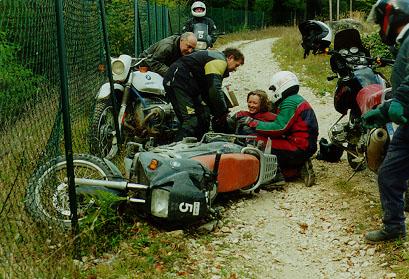
In November 1997, I visited the BMW enduro-course in Hechlingen, Germany, together with Roland, Pim, and Ernst.
The course was organised by Richard Schalber. We hired BMW R11GSses at the site (as you will see below, this is recommended because of several reasons).
Our instructors were Gregor (for the advanced enduro riders: Ernst) and Winfried (for the beginners: Roland, Pim and me).
Most fellow-riders rode on BMW R11GSses; a few had hired an F650, and several advanced riders did it on XR's (if I remember correctly). At the end of the course, I was riding the BMW R80 Basic which you see here.
Below, I will summarize what we learned, and I will explain the modifications on the Beemers. (Oh, and the pictures you see are from Pim).
What we learned: Standing on the pegs
Lesson number one. On a BMW R11GS, in enduro circumstances, always stand on the pegs. This gives you better control over the motorcycle. To perform tight curves, you can push it aside.
Of course, we had to do extremely tight curves :-( (which is my very weakest point).
Apart from standing on the pegs, we did some motorcycle gymnastics (like standing on the saddle, sitting with both legs to one side, etc), to gain confidence and control (to my very big astonishment, I managed to perform all exercises).
What we learned: Picking up a Beemer
Winfried promised us that we would fall a lot (and he kept his promises, as you can see in the pictures, which show only a very minor part of all the accidents that took place). He did not intend to pick up the motorcycles all the time, so we had to learn ourselves.
The trick is to turn the handlebars so that the wheel points upwards. Then you grab the handlebar nearest to the ground, bend your knees and keep your back straight, and straighten your legs. Of course, it did not work for me. I cracked my back the first time I tried (so, for the rest of the course, I almost could not walk anymore; riding a motorcycle, even standing on the pegs, was much better ;-)
Later on, I tried the same trick with a BMW R80G/S, and it worked.
There is only one way for me to pick up my GS: sit next to it, with my back towards the saddle. Then I grab the bike by its saddle, bend my knees, and stretch my legs, trying to have maximum grip with my heels on the ground. The difficult part is when standing up: you have to feel when the time has come to turn around, otherwise the bike will fall over to the other side.
What we learned: Riding uphill
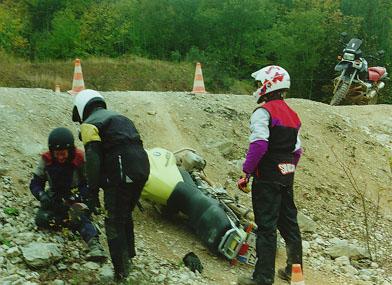
When riding uphill, you give some extra gas just before going up (never too much). Just before the top, you take the gas back. When you do it like t hat, you will arrive at the top very gently, and very slowly.
Which means that you will be able to take tight turns immediately after the slope, which is often necessary.
Never grab the clutch, because a beemer is very heavy, and will slide downward, often on top of you.
When the bike stalls because you did not give enough gas, just let it stall.
As you see, even then it sometimes falls on your knee :-(
What we learned: Riding downhill
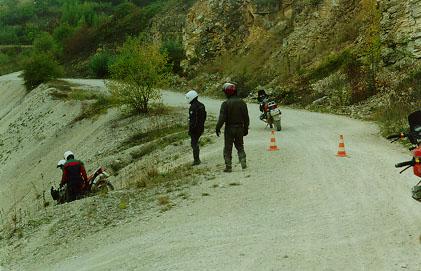
Riding downhill is much more scarier then upwards!!! The beemers brake a lot on their compression which helps (at this moment during the course, I rode an R80Basic, which braked considerably less).
When you still go too fast downward, it is possible to brake: use the front brake (very gently of course), and make sure that you don't stall the bike. You can even apply the clutch, if necessary.
Using this technique, I was able to go downhill, and almost stop halfway, and go on then. But even though I managed that, I could not bring myself to do the steepest downhill sections (which I had ridden upwards), because of my nauseating fear of heights :-(
(next time, I will do them!!!)
What we learned: Riding through water
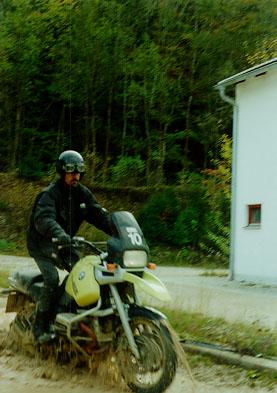
The trick in this case, is to approach the water gently, and, when the front wheel is in, hang on to the gas. The bottom is often slippery, and in this case, full of gravel and stones. The bike needs a lot of gas to get through (but of course, when you open it fully, you will slide).

We all managed to come through though. And, as you see in the picture showing me on the Basic, Beemers are almost able to swim!
Modifications on the Beemers
In the first place, they had Continental TKC80 tires. Suitable for the road, but far better in terrain then Michelins T66X, or the Metzelers that are available for the R11GS. The difference I found most noticable (until then, I rode on Michelins), was that tracks (in sand or mud) were much easier with these tires. With the Michelins, the only way to tackle tracks, was to keep in them. With these tires, you didn't need to look at tracks: the tires climb easily out of a track, so you can concentrate on more important terrain aspects.
In the second place, the amount of rpm at idle time was set slightly higher then usual. We were able to keep riding in first, when idling. This is very comfortable in a lot of circumstances!
At the same time, synchronization was optimized at about 2000 rpm, instead of at the usual 5500. This means that the bike runs a lot smoother in the lower rpm's, and because we almost constantly rode in first for two days, this is a clever thing to do for off-road riding.
They also had a modification to prevent the frame from braking.
Hechlingen
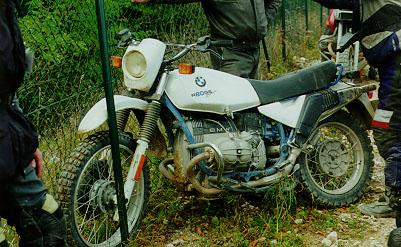
In the very first place, I want to state that the instructors we had were very very good. Not only in riding, but also in teaching.
Winfried was perfect for the beginners: he had a lot of patience, was never tired of explaining things for the tenth time (and each time in a different way), of encouraging you and telling you that you performed very well, of explaining in detail what you could do better, and how, and at the same time, to squeeze the utmost you could manage out of you ;-) (I think I have never been so tired in my life).
Gregor was perfect for the advanced riders: challenging them all the time, showing them stunts they would never be able to mimick, but which kept them trying, showing them how much fun it is to do things on a beemer that everybody would swear is not possible.
(When riding to the village for lunch, Gregor said that we would go slowly, not to disturb the villagers. Well, we rode in exactly the same way as with a bunch of baggerraggerraars, which is faster then most motorcyclists will ever ride on a big wide road, and this was a tiny, mud-covered one ;-)
We fell a lot, Roland, Pim, Ernst and me (and all the others too). On the second day, when the beemer fell on my knee, and I could hardly get up because of my back, I was given the much lighter R80Basic, and I fell in love with it. As you can see, you can park it very easily ;-)
(Alas, this was at an uphill section, were I could not find Winfried, so I hesitated before turning left or right, which resulted in turning too late. The next rider did not see me, and rode right into me, when I had descended, as you can see in the picture in the beginning).
Among the worst accidents was the one of Roland. We did a brake exercise, riding at relatively high speed towards Winfried, who showed you to go left or right at the very last moment. Roland managed to ride fast (he planned to get Winfried on the duck-bill of his GS), and to brake at the last moment. Unfortunately, his balls crashed into the tank (I am often glad to be a girl, but especially at moments like this one).
At the end of the second day, we received an "Urkunde". Everybody who had to step forward did so walking crippled, and stiff. And everybody was already looking forward to the next occasion ;-)
Copyright 1993-now.
For comments, e-mail adress: sylviastuurman@gmail.com